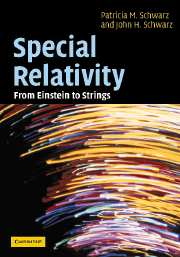Book contents
- Frontmatter
- Contents
- Preface
- Part I Fundamentals
- Part II Advanced Topics
- 7 When quantum mechanics and relativity collide
- 8 Group theory and relativity
- 9 Supersymmetry and superspace
- 10 Looking onward
- Appendix 1 Where do equations of motion come from?
- Appendix 2 Basic group theory
- Appendix 3 Lie groups and Lie algebras
- Appendix 4 The structure of super Lie algebras
- References
- Index
7 - When quantum mechanics and relativity collide
Published online by Cambridge University Press: 06 July 2010
- Frontmatter
- Contents
- Preface
- Part I Fundamentals
- Part II Advanced Topics
- 7 When quantum mechanics and relativity collide
- 8 Group theory and relativity
- 9 Supersymmetry and superspace
- 10 Looking onward
- Appendix 1 Where do equations of motion come from?
- Appendix 2 Basic group theory
- Appendix 3 Lie groups and Lie algebras
- Appendix 4 The structure of super Lie algebras
- References
- Index
Summary
The twentieth century gave birth to three major conceptual revolutions in human understanding of the fundamental physical principles that characterize how the Universe works. They are relativity (both special and general), quantum mechanics, and string theory. The first two arose in the early part of the century and are supported by overwhelming experimental and observational evidence. The latter (string theory) arose much later – around 1970 – and is much more speculative than relativity or quantum mechanics, though most practitioners are completely convinced that it is also an essential ingredient of the story. String theory is certainly every bit as mind-bending in its implications as relativity and quantum mechanics.
The primary purpose of this book, as its title indicates, is to explain and explore the special theory of relativity. However, this also gives us license to explore its interplay with other profound ideas. By confronting quantum theory with relativity physicists were led to uncover remarkable concepts and insights. A thorough treatment of relativistic quantum mechanics is the subject of quantum field theory and is beyond the scope of this book. This chapter will present an overview of the basics. (Why should all the fun be reserved for the specialists?) Our brief treatment will serve as a general introduction for students who have not studied these matters before. Those who have may find a few surprises.
- Type
- Chapter
- Information
- Special RelativityFrom Einstein to Strings, pp. 221 - 259Publisher: Cambridge University PressPrint publication year: 2004



